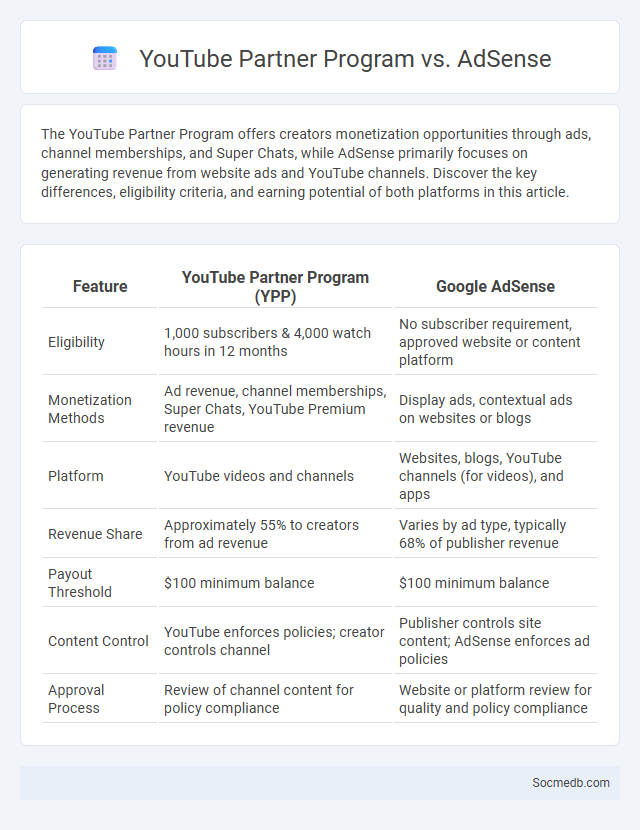
Photo illustration: YouTube Partner Program vs AdSense
The YouTube Partner Program offers creators monetization opportunities through ads, channel memberships, and Super Chats, while AdSense primarily focuses on generating revenue from website ads and YouTube channels. Discover the key differences, eligibility criteria, and earning potential of both platforms in this article.
Table of Comparison
| Feature | YouTube Partner Program (YPP) | Google AdSense |
|---|---|---|
| Eligibility | 1,000 subscribers & 4,000 watch hours in 12 months | No subscriber requirement, approved website or content platform |
| Monetization Methods | Ad revenue, channel memberships, Super Chats, YouTube Premium revenue | Display ads, contextual ads on websites or blogs |
| Platform | YouTube videos and channels | Websites, blogs, YouTube channels (for videos), and apps |
| Revenue Share | Approximately 55% to creators from ad revenue | Varies by ad type, typically 68% of publisher revenue |
| Payout Threshold | $100 minimum balance | $100 minimum balance |
| Content Control | YouTube enforces policies; creator controls channel | Publisher controls site content; AdSense enforces ad policies |
| Approval Process | Review of channel content for policy compliance | Website or platform review for quality and policy compliance |
Introduction to YouTube Monetization Options
YouTube offers various monetization options that enable content creators to generate revenue through their videos. These include ad revenue from Google AdSense, channel memberships, Super Chat during live streams, and merchandise shelf integration. Understanding these options helps you maximize your earning potential on the platform.
What is the YouTube Partner Program (YPP)?
The YouTube Partner Program (YPP) enables content creators to monetize their videos by earning revenue through ads, channel memberships, and Super Chat. Eligibility requires at least 1,000 subscribers and 4,000 valid watch hours in the past 12 months, alongside adherence to YouTube's policies. Once accepted, creators gain access to advanced features, analytics, and support to grow their channels effectively.
Understanding Google AdSense for Content Creators
Google AdSense enables content creators to monetize their websites and social media platforms by displaying targeted ads, generating revenue through clicks or impressions. Understanding AdSense's key features, such as ad placement, content policies, and payment thresholds, enhances a creator's ability to maximize earnings while maintaining compliance. Integrating AdSense with high-quality content and consistent traffic growth significantly boosts income potential for digital influencers and bloggers.
Other Partner Programs for Video Creators
Other Partner Programs for Video Creators provide alternative monetization opportunities beyond traditional advertising revenue. These programs often include brand sponsorships, affiliate marketing, and content licensing, enabling creators to diversify income streams. Platforms like YouTube, TikTok, and Instagram offer specialized partnership options tailored to video content, enhancing creator engagement and revenue potential.
Eligibility Requirements Comparison
Eligibility requirements for social media platforms vary based on age, location, and account type, with most requiring users to be at least 13 years old to comply with COPPA regulations. Platforms like Facebook and Instagram enforce country-specific restrictions, ensuring users meet local legal standards, while professional networks such as LinkedIn also mandate real identity verification for account creation. Understanding these distinctions helps users select appropriate platforms and maintain compliance with respective terms of service and privacy policies.
Monetization Features: YPP vs. AdSense vs. Partner Programs
You can maximize your social media earnings by understanding the differences between Monetization Features like YouTube Partner Program (YPP), AdSense, and platform-specific Partner Programs. YPP allows creators to earn through ads, memberships, and super chats directly on YouTube, while AdSense serves as a broader advertising network linking your content to relevant ads across various websites. Partner Programs on platforms like Facebook, TikTok, or Instagram offer tailored revenue opportunities including branded content, in-stream ads, and affiliate links to diversify your income streams.
Revenue Streams and Payment Models
Social media platforms generate revenue primarily through advertising models such as pay-per-click (PPC), cost-per-impression (CPM), and sponsored content, leveraging vast user engagement data to optimize targeted ads. Subscription services and premium features offer alternative payment models, providing users with ad-free experiences, exclusive content, or enhanced functionalities. E-commerce integrations, including in-app purchases and affiliate marketing, further diversify income streams by facilitating direct sales and brand collaborations.
Pros and Cons of Each Monetization Program
Facebook offers in-stream ads enabling creators to earn revenue from video content, but strict eligibility requirements may limit participation. YouTube's Partner Program provides multiple monetization options such as ad revenue, channel memberships, and Super Chats, though demonetization policies can impact earning stability. TikTok Creator Fund rewards engaging content with financial incentives, yet payout rates vary and depend heavily on video performance metrics.
Choosing the Best Monetization Path for Your Channel
Selecting the best monetization path for your social media channel depends on understanding your audience demographics and engagement patterns. Platforms like YouTube offer ad revenue sharing, while Instagram and TikTok enable influencer marketing and brand partnerships tailored to your niche. Optimizing revenue streams such as sponsored content, affiliate marketing, and merchandise sales ensures that your channel's growth aligns with sustainable income opportunities.
Frequently Asked Questions (FAQs)
Social media FAQs commonly address topics such as account setup, privacy settings, and content sharing guidelines to help users navigate platforms efficiently. You can find solutions for password recovery, profile customization, and managing notifications to enhance your online experience. Understanding platform-specific rules and algorithms ensures your content reaches the right audience while maintaining security and engagement.
 socmedb.com
socmedb.com